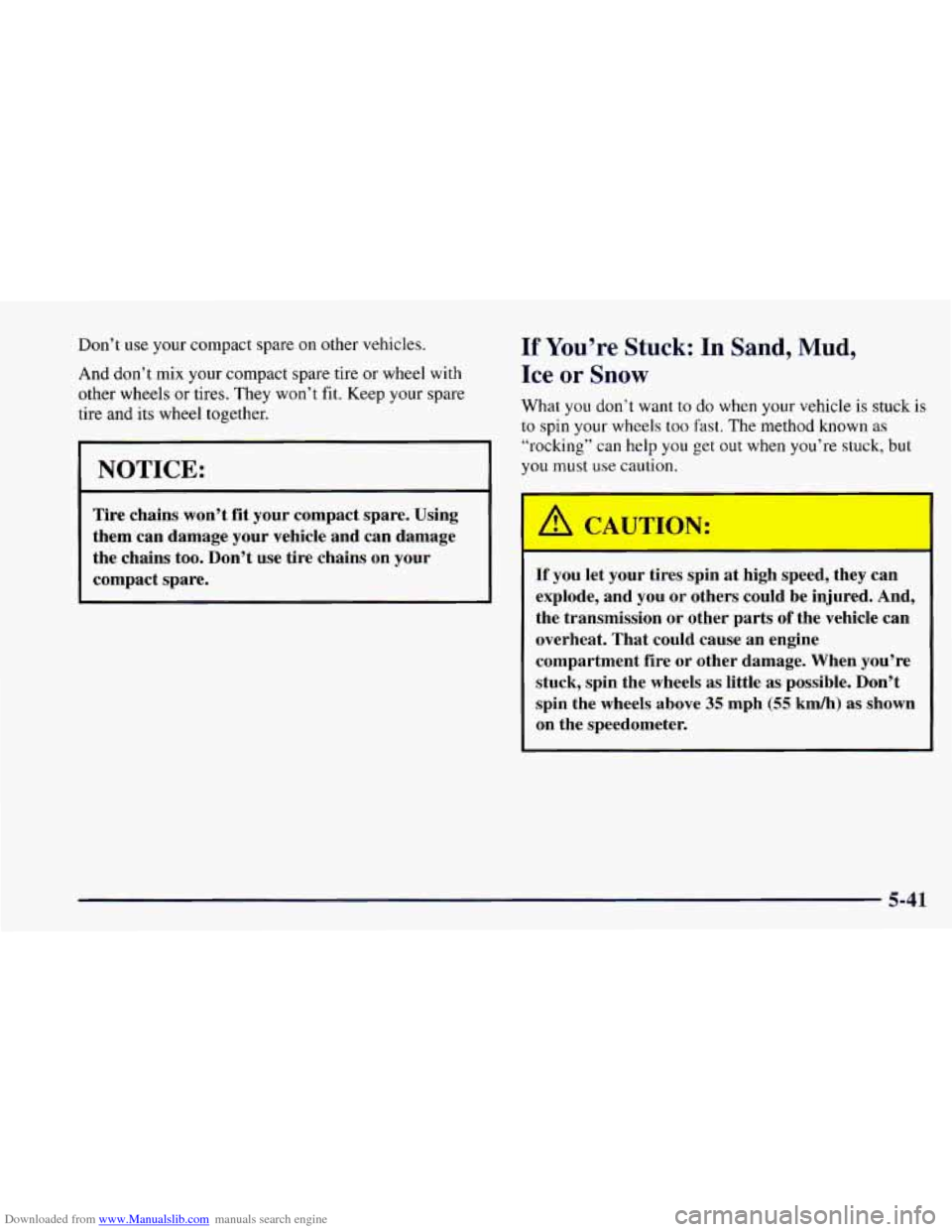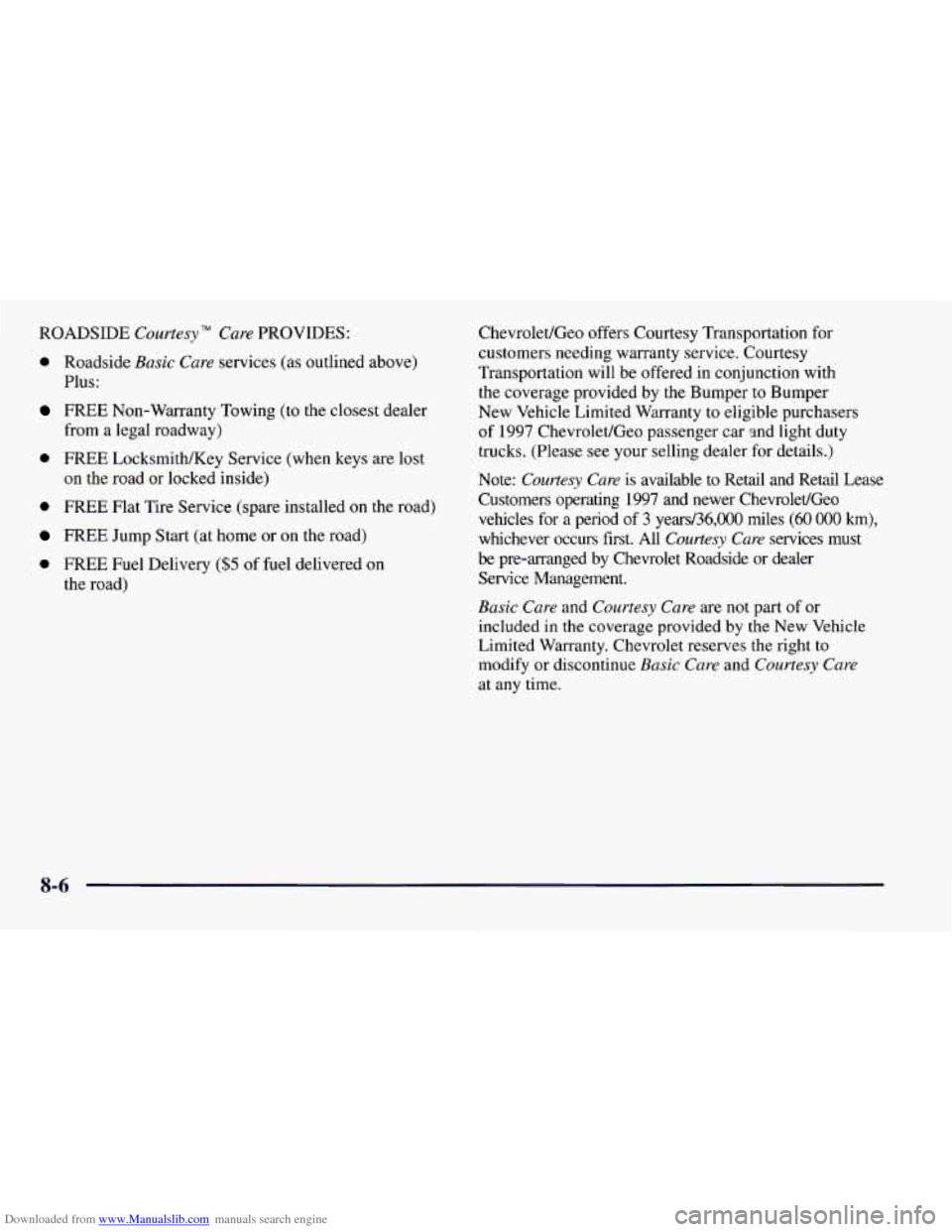1997 CHEVROLET CAMARO spare tire
[x] Cancel search: spare tirePage 243 of 404

Downloaded from www.Manualslib.com manuals search engine II
I
Replace the jack, wheel wrench and flat tire using the
storage instructions. When you replace the trim panel,
be sure to tuck it under the weatherstrip.
1.
2.
3.
4.
5.
6.
7.
8.
9.
10.
Trim Panel
Bolt
Cover
Jack Wing
Nut
Adapter
Compact Spare Tire
Full-Size Tire
Carpet Flap
Tire Storage Bolt
5-39
Page 244 of 404

Downloaded from www.Manualslib.com manuals search engine Compact Spare Tire
Although the compact spare tire was fully inflated when
your vehicle was new, it can
lose air after a time. Check
the inflation pressure regularly. It should
be 60 psi
(420 Ea).
After installing the compact spare on your vehicle, you
should stop as soon as possible and make sure your spare
tire
is correctly inflated. The compact spare is made to
perform well at speeds up to 65 mph (105 km/h) for
distances up to
3,000 miles (5 000 km), so you can finish
your trip and have your full-size tire repaired or replaced
where
you want. (When the compact spare is used on
the rear axle, see Notice below.) Of course, it’s best to
replace your spare
with a full-size tire as soon as you can.
Your spare will last longer and be in good shape in case
you need it again.
When the compact spare
is on the rear axle, the optional
ASR system will cycle and limit acceleration for about
the first
15 seconds of driving after each engine start.
I I
NOTICE:
If the compact spare is used as a rear tire, do not
drive faster than 50 mph (80 km/h). Damage to
the rear axle may occur
if the compact spare is
driven faster than 50 mph (80 W).
NOTICE:
When the compact spare is installed, don’t take
your vehicle through an automatic car wash with
guide rails. The compact spare can get caught on
the rails. That can damage the tire and wheel,
and maybe other parts
of your vehicle.
5-40
Page 245 of 404

Downloaded from www.Manualslib.com manuals search engine Don’t use your compact spare on other vehicles.
And don’t mix your compact spare tire or wheel with
other wheels or tires. They won’t fit. Keep your spare
tire and its wheel together.
NOTICE:
Tire chains won’t fit your compact spare. Using
them can damage your vehicle and can damage
the chains too. Don’t use tire chains on your
compact spare.
If You’re Stuck: In Sand, Mud,
Ice
or Snow
What you don’t want to do when your vehicle is stuck is
to spin
your wheels too fast. The method known as
“rocking” can help you get out when you’re stuck, but
you
must use caution.
I If you let your tires spin at high speed, they can
explode, and you or others could be injured. And,
the transmission or other parts
of the vehicle can
overheat. That could cause an engine
compartment fire or other damage. When you’re
stuck, spin the wheels
as little as possible. Don’t
spin the wheels above
35 mph (55 kmh) as shown
on the speedometer.
5-41
Page 297 of 404

Downloaded from www.Manualslib.com manuals search engine Inflation -- Tire Pressure
The Tire-Loading Information label, which is on the
driver’s door shows the correct inflation pressures
for
your tires when they’re cold. “Cold” means your vehicle
has been sitting for
at least three hours or driven no
more than 1 mile
(1.6 km).
If you’ll be driving at speeds higher than 100 mph
(160 km/h) where it is legal, raise the cold inflation
pressure
of each tire to 35 psi (240 kPa). When you
end this very high-speed driving, reduce the cold
inflation pressures to those listed on the Tire-Loading
Information label.
NOTICE:
Don’t let anyone tell you that underinflation or
overinflation is all right.
It’s not. If your tires
don’t have enough air (underinflation), you can
get the following:
NOTICE: (Continued) NOTICE:
(Continued)
Too much flexing
Too much heat
Tire overloading
Bad wear
Bad handling
0 Bad fuel economy.
If your tires have too much air (overinflation),
you can get the following:
Unusual wear
0 Bad handling
Rough ride
Needless damage from road hazards.
When to Check
Check your tires once a month or more.
Don’t forget your compact spare tire. It should be at
60 psi (420 kPa).
6-51
Page 299 of 404

Downloaded from www.Manualslib.com manuals search engine L
If you have P245/50ZR 16 or P275/40ZR17 Goodyear
Eagle GS-C tires, they must roll in a certain direction
for the best overall performance. The direction is shown
by an arrow
on the sidewall. Because these tires are
directional, they
should be rotated as shown here. These
tires should
only be moved from front to rear and rear to
front on the same side of the vehicle.
Don’t include the compact spare tire in your tire rotation. After the tires have been rotated,
adjust the front and
rear inflation pressures as shown
on the Tire-Loading
Information label. Make certain that all wheel
nuts are
properly tightened.
See “Wheel Nut Torque” in
the Index.
Rust or dirt on a wheel, or on the parts to which
it is fastened, can make wheel nuts become loose
after a time. The wheel could come
off and cause
an accident. When you change a wheel, remove
any rust or dirt from places where the wheel
attaches to the vehicle. In an emergency, you can
use a cloth or a paper towel to do this; but be
sure to use
a scraper or wire brush later, if you
need to, to get all
the rust or dirt off. (See
“Changing
a Flat Tire” in the Index.)
6-53
Page 301 of 404

Downloaded from www.Manualslib.com manuals search engine Mixing tires could cause you to lose control while
driving.
If you mix tires of different sizes or types
(radial and bias-belted tires), the vehicle may not
handle properly, and you could have
a crash.
Using tires of different sizes may also cause
damage to your vehicle. Be sure to use the same
size and type tires on all wheels,
It's all right to drive with your compact spare,
though. It
was developed for use on your vehicle,
Uniform Tire Quality Grading
The following information relates to the system
developed by the United States National Highway
Traffic Safety Administration, which grades tires by
treadwear, traction and temperature performance. (This
applies only to vehicles sold in the United States.) The
grades are molded on the sidewalls
of most passenger car
tires. The Uniform Tire Quality Grading system
does not apply
to deep tread, winter-type snow tires,
space-saver or temporary use spare tires, tires with
nominal rim diameters
of 10 to 12 inches (25 to 30 cm),
or to some limited-production tires.
While the tires available on General Motors passenger
cars and light trucks may vary with respect to these
grades, they must also conform
to Federal safety
requirements and additional General Motors Tire
Performance Criteria (TPC) standards.
Treadwear
The treadwear grade is a comparative rating based on
the wear rate of the tire when tested under controlled
conditions on a specified government test course. For
example, a tire graded 150 would wear one and a half
'( 1 1/2) times as well on the government course as a tire
graded 100. The relative performance
of tires depends
upon the actual conditions of their use, however, and
may depart significantly from the norm due to variations
in driving habits, service practices and differences in
road characteristics and climate.
6-55
Page 382 of 404

Downloaded from www.Manualslib.com manuals search engine ROADSIDE Courtesy TM Care PROVIDES:
0 Roadside Basic Care services (as outlined above)
Plus
:
FREE Non-Warranty Towing (to the closest dealer
0 FREE LocksmitWKey Service (when keys are lost
0 FREE Flat Tire Service (spare installed on the road)
FREE Jump Start (at home or on the road)
0 FREE Fuel Delivery ($5 of fuel delivered on
from a legal roadway)
on the road or locked inside)
the road) Chevrolet/Geo offers Courtesy Transportation
for
customers needing warranty service. Courtesy
Transportation will be offered in conjunction with
the coverage provided by the Bumper
to Bumper
New Vehicle Limited Warranty
to eligible purchasers
of 1997 ChevroletlGeo passenger car 2nd light duty
trucks. (Please see your selling dealer for details.)
Note:
Courtesy Care is available to Retail and Retail Lease
Customers operating 1997 and newer Chevrolet/Geo
vehicles for
a period of 3 years/36,000 miles (60 000 km),
whichever occurs first. All Courtesy Care services must
be pre-arranged by Chevrolet Roadside or dealer
Service Management.
Basic Care and Courtesy Care are not part of or
included
in the coverage provided by the New Vehicle
Limited Warranty. Chevrolet reserves the right to
modify or discontinue Basic Care and Courtesy Care
at any time.
8-6
Page 393 of 404

Downloaded from www.Manualslib.com manuals search engine Close-Out Panel ................................ 2-58
Clutch. Hydraulic
............................... 6-26
Comfort Controls
................................ 3-2
CompactDisc
.................................. 3-16
Care
....................................... 3-24
Player
...................................... 3-16
Player Errors
........................... 3- 15. 3. 1 8
Storage
..................................... 2-58
Compact Spare Tire
............................. 5-40
Content Theft-Deterrent
......................... 2- 14
AlarmFanicMode ............................. 2-8
Feature Customization
......................... 2- I8
Control of a Vehicle .............................. 4-5
Convertible Top
................................ 2-68
Convex Outside Mirror
.......................... 2-57
Coolant
....................................... 6-28
Bleed Valves
............................ 5.22. 5.26
Heater. Engine
............................... 2-27
RecoveryTank
............................... 5-18
Cooling System
................................ 5-16
Courtesy Lamps
................................ 2-54
Courtesy Transportation
........................... 8-8
Cruise Control ................................. 2-48
Resuming
a Set Speed ......................... 2-50
Setting
..................................... 2-49
Customer Assistance for Text Telephone Users
......... 8-4
Customer Assistance Information
................... 8- 1
Customer Satisfaction Procedure .................... 8-2
Damage. Finish
............................... 6-66
Damage. Sheet Metal
............................ 6-65
Daytime Running Lamps
......................... 2-52
Dead Battery
................................... 5-3 Defects. Reporting Safety
........................ 8-10
Defensive Driving
............................... 4-2
Defogging
..................................... 3-5
Defrosting
..................................... 3-5
Delayed Illumination
............................ 2-55
Dimen ions. Vehicle
............................ 6-76
Dolby
& B Noise Reduction ....................... 3-12
Door
Last Door Closed Locking Feature
................ 2-6
Lockout Prevention
............................ 2-6
Locks
....................................... 2-4
Downshifting
.................................. 2-35
Drive Position. Automatic Transmission
............. 2-31
Driver Position ................................. 1-12
Driving Defogger. Rear Window
.......................... 3-5
Driver’s Door Alarm Delay/Shock Sensor Enable
..... 2-22
City
........................................ 4-21
Defensive
.................................... 4-2
Drunken
..................................... 4-2
Freeway
.................................... 4-22
InaBlizzard
................................. 4-28
In Foreign Countries
........................... 6-5
IntheRain
.................................. 4-18
Night
...................................... 4-16
OnCurves
.................................. 4-11
On Grades While Towing a Trailer ............... 4-38
On Hill and Mountain Roads
.................... 4-24
On Snow and Ice
............................. 4-27
Throughwater
............................... 4-20
WetRoads
.................................. 4-18
Winter
...................................... 4-26
With a Trailer
................................ 4-37
Drunken Driving
................................ 4-2
9-3